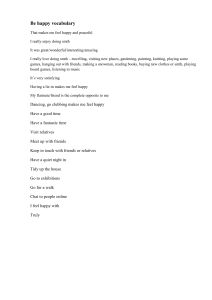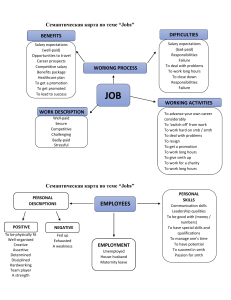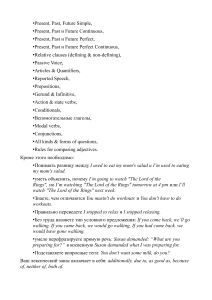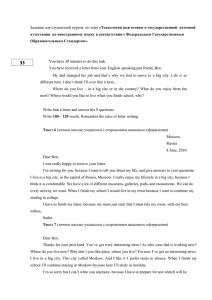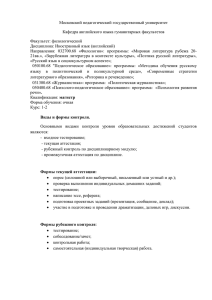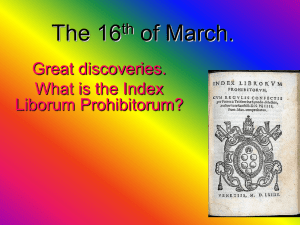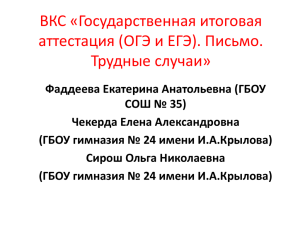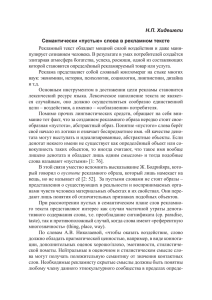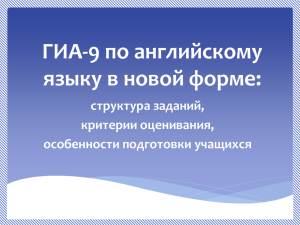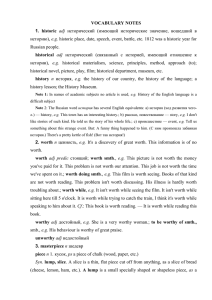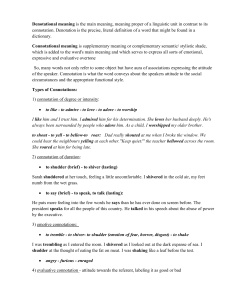английский язык_очное - Московский педагогический
реклама
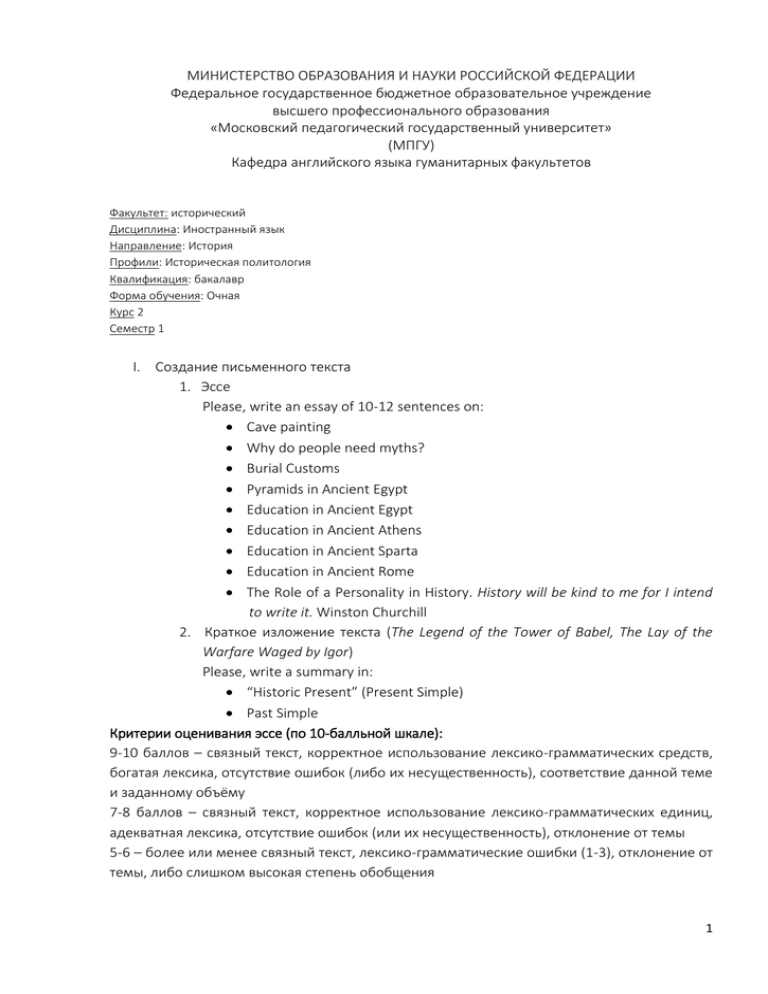
МИНИСТЕРСТВО ОБРАЗОВАНИЯ И НАУКИ РОССИЙСКОЙ ФЕДЕРАЦИИ Федеральное государственное бюджетное образовательное учреждение высшего профессионального образования «Московский педагогический государственный университет» (МПГУ) Кафедра английского языка гуманитарных факультетов Факультет: исторический Дисциплина: Иностранный язык Направление: История Профили: Историческая политология Квалификация: бакалавр Форма обучения: Очная Курс 2 Семестр 1 I. Создание письменного текста 1. Эссе Please, write an essay of 10-12 sentences on: Cave painting Why do people need myths? Burial Customs Pyramids in Ancient Egypt Education in Ancient Egypt Education in Ancient Athens Education in Ancient Sparta Education in Ancient Rome The Role of a Personality in History. History will be kind to me for I intend to write it. Winston Churchill 2. Краткое изложение текста (The Legend of the Tower of Babel, The Lay of the Warfare Waged by Igor) Please, write a summary in: “Historic Present” (Present Simple) Past Simple Критерии оценивания эссе (по 10-балльной шкале): 9-10 баллов – связный текст, корректное использование лексико-грамматических средств, богатая лексика, отсутствие ошибок (либо их несущественность), соответствие данной теме и заданному объёму 7-8 баллов – связный текст, корректное использование лексико-грамматических единиц, адекватная лексика, отсутствие ошибок (или их несущественность), отклонение от темы 5-6 – более или менее связный текст, лексико-грамматические ошибки (1-3), отклонение от темы, либо слишком высокая степень обобщения 1 3-4 – недостаточно хорошая, с точки зрения логики, организация текста, лексикограмматические ошибки (более 3), отклонение от темы, высокая степень обобщения в изложении, или недостаточный объём 1-2 – отсутствие логики в изложении, лексико-грамматические ошибки (более 3), отклонение от темы, высокая степень обобщения в изложении, или недостаточный объём Критерии оценивания краткого изложения текста (по 5-балльной): 4-5 баллов – последовательность изложения, правильное использование глаголов в Present Simple и Past Simple, отсутствие ошибок (либо их несущественность) 2.3 балла – ошибки в употреблении двух времён, несущественные лексические ошибки 1 балл – недостаточная последовательность в изложении, ошибки в употреблении двух времён, лексические ошибки, недостаточный объём II. Контрольное чтение и устная речь 1. Контрольное чтение: на материале отрывка из художественной литературы по выбору студента/преподавателя (см. Приложение 1) на материале текстов по тематике разделов пособия (см. Приложение 2) 2. Рассуждение на заданную тему в течение 3 минут темы эссе (см. пункт I) The evolution of: FAMILY, MASS MEDIA, SUPERPOWER, SPORT, EDUCATION, ART, WAR, TRAVEL, GOD – in the course of history Критерии оценивания контрольного чтения (по 5-балльной шкале): 5 баллов – темп, адекватный тематике и стилю текста, соблюдение правил английской интонации, правильное произношение слов, выразительность 4 балла – темп, адекватный тематике и стилю текста, соблюдение правил английской интонации, незначительные огрехи в произношении слов 3 балла – незначительные нарушения темпа, интонации, ошибки в произношении слов (13) 2 балла – незначительные нарушения темпа, интонации, более 3 ошибок в произношении слов 1 балл – нарушения темпа, интонации, более 3 ошибок в произношении слов Критерии оценивания речи на заданную тему - (по 10-балльной шкале): 9-10 баллов – беглая речь, последовательность, корректное использование лексикограмматических средств, богатая лексика, отсутствие ошибок (либо их несущественность), соответствие заданной теме и отведённому времени 7-8 баллов – беглая речь, корректное использование лексико-грамматических средств, богатая лексика, отсутствие ошибок (либо их несущественность), отклонение от заданной темы, недостаточный контроль за временем 2 5-6 баллов – недостаточная беглость речи, лексико-грамматические ошибки (1-3), отклонение от заданной темы или высокая степень обобщения, недостаточный контроль за временем 3-4 балла – недостаточная беглость речи, более 3 лексико-грамматических ошибок, отклонение от данной темы, высокая степень обобщения, недостаточный контроль за временем 1-2 балла – бессвязная речь, более 3 лексико-грамматических ошибок, отклонение от данной темы, высокая степень обобщения, отсутствие контроля за временем SOCRATES PLATO ARISTOTLE III. Задания для текущего контроля уровня знаний 1. How did these three contributed to the world culture and education? Make up sentences in Past Simple, using the following verbs and expressions and translate them: To examine smth The development of science Early childhood education To develop smth Physical training Corporal punishment To define smth The Lyceum Curriculum To educate smb in smth Women education The philosophy of idealism To found smth = to establish smth The study of politics Dialectic method To advocate smth = to publicly support smth Morality and the “good” life Religion To oppose smth The development of student abilities Self-knowledge To contribute to smth Citizenship Art of debating To question smth Alexander the Great Critical thinking To teach, to be the tutor of smb 2. Complete the sentences, using the passive form verbs : to make to discover to found to make to wound to establish PASSIVE VOICE: to be (in Present or Past Simple) + Participle II. EXAMPLE: The pyramids were built of huge limestone blocks (material) The pyramids were built by the ancient Egyptians (actor) The “Lay of the Warfare Waged by Igor” ______ unknown author. ___________ ____ an 3 The tablets _____ __________ _____ wax. The prince Igor _____ ____________ and __________ prisoner _____ the Polovtsy. Primitive weapons _____ _____________ _____ stone. The Rosetta stone ______ ______________ ____ one of the Napoleon’s soldiers. The Academy _____ _______________ _____ Plato. The Lyceum _____ _________________ _____ Aristotle. 3. Complete the words in the sentences and translate them: QUINTILIAN BELIEVED THAT: Early childhood ed_____________ was very important. Children should be exposed to proper sp________ as kids are very good at im____________ . The material should be se__________ for students. Education f_________ morality and b_______ character. School should t_____ proper behavior. C________ punishment is in___________ and cause psychological h______ . IV. Задания итогового контроля (зачёт) 1. Complete the sentences, changing the words given: V.1. Archaeologists ____________________________ in the mound gold rings, earrings, a gold medallion and a gold vessel with remains of perfumes, inlaid with filigree and precious stones - a masterpiece of a jeweler. COVER As a result of democratic revolutions, some monarchs were _________________________and republics were proclaimed. THROW Like other Indians of the period, Sequoyah was ___________________________, but his determination to remedy the situation led to the invention of a unique 86character alphabet based on the sound patterns that he heard. LITERACY The God confused human ____________________ after they had attempted to reach the heaven. SPEAK Poetry and literature are very important means of influencing public opinion, and patronage of poets and writers was in fact a part of Augustus' national policy carried out by Gaius Maecenas, the emperor's friend and ___________________. ADVICE Imitation is a major method of ________________________ in early education. INSTRUCT 4 ___________________________ and ____________________________ were the major methods of instruction in ancient times. IMITATE, MEMORY In Rome, the responsibility of decision-making fell almost ___________________________ upon the citizen-members of the Assembly. EXCLUDE History helps one to _____________________ the course of events in the future. SEE The similarities between Mayan tombs and the crypts of the Egyptian pharaohs who ruled are __________________. STRIKE Like _________________________, archaeologists go into the field to locate and preserve all kinds of information. DETECT The works of Aristotle, Plutarch, and a few other Greek authors, constituted the treasure, from which Italian poets of Renaissance drew their _______________________. INSPIRE Burial practices as archeological source allow a ___________________________ of the process of ____________________________ of one archaeological culture by another. PLACE _______________________, in the construction of roads, houses and dams, thousands of rock _____________________ and paintings were destroyed. FORTUNE, CARVE The mythological characters and images ________________________ the wisdom of the peoples of the world, their thoughts about their history and most important cultural achievements. CORPS V.2. Though in early days a calendar was required ___________________________ for religious observance, it was used for civil purposes as well. PRIME Gladiators were people who were given arms and made to fight against each other for the amusement of __________________________. SPECTRUM The Mayan system of writing presents a _________________________ stage of advancement. MARK Inside the tombs, grave goods __________________________ the corpse into the afterlife. COMPANY The _______________________ practices of Inca and pre-Inca societies required that members of the ruling elite should be mummified, wrapped in exquisite textiles, and laid in _________________ chambers accompanied by gold and silver objects, high quality ceramics, and beautifully ornamented wooden and metal tools. BURY In Ancient Egypt officials who could read and write, were required for all posts in the highly _______________________ administration. CENTRE 5 In Armenia, archeologists discovered stone tablets with ____________________________ that were carved on them more than two thousand five hundred years ago. SCRIPT In the article "Fine Arts and Mythology" the author traces the _______________________________ roots of art, from the cave paintings to the Renaissance artists. MYTH The ___________________________ of libraries started in the 15 th century. SYSTEM In 1850 the famous English archaeologist Layard, being then engaged in ______________________ Assurbanipal's palace (VII c. B.C.), came across several chambers containing a great number of records - decrees of Assyrian kings, accounts of wars, works on astronomy - as well as dictionaries and text-books. EARTH The history of _________________________ begins with the primitive community. MAN Archaeologists uncovered in the mound gold rings, earrings, a gold medallion and a gold vessel with remains of perfumes, ________________________ with filigree and precious stones - a masterpiece of a jeweler. LAY The subject of serious scholarship and sensational speculation, it has been argued that the Nazca Lines are a gigantic astronomical calendar, ritual pathways, or even runways for visitors from ______________________ space! OUT Archaeologists uncovered in the mound gold rings, earrings, a gold medallion and a gold vessel with remains of perfumes, inlaid with filigree and precious stones - a ____________________________ of a jeweler. PIECE Wars, except just ones, were always waged for the purpose of conquering other lands and peoples. All the monarchs brutally _____________________their own people, and ______________________ and plundered the conquered nations. PRESS, SLAVE The original Neandertal was originally thought to be a misshapen freak from the Middle Ages. But soon more bones with the same strange features were ____________________________ in Belgium, France, and other parts of Europe. EARTH Obviously, the young Sarmatian woman whose remains were uncovered by the archeologists was also a _________________________. PRIEST Earliest inhabitants of Europe who created primitive ___________________________ – stone structures like Stonehenge. OBSERVE Pompey was one of the greatest Roman soldiers, a talented political leader and a diplomat. He suppressed an __________________________ of gladiators. RISE The _____________________ of bows and arrows helped to start cattle-breeding, and axes made it possible to go over to farming. INVENT V.3. 6 A complete Latin __________________________ of the Iliad and Odyssey, though a very bad one, was made at Petrarch’s suggestion, and with Boccaccio’s help, by a Calabrian Greek, Leonzio Pilato. TRANSLATE The name of Stone Age was derived from the stone tools and weapons that modern ______________________ found. SCIENCE The old library included a kind of catalogue and a systematic _____________________________ of shelves. RANGE Thanks to archeology, we can examine social ___________________________ in ancient times. DIFFER ____________________________ uncovered in the mound gold rings, earrings, a gold medallion and a gold vessel with remains of perfumes, inlaid with filigree and precious stones - a masterpiece of a jeweler. ARCHEOLOGY The statue of Zeus was made by Phidias for the temple in Olympia. Zeus was seated on a golden throne decorated with precious stones. The fate of it is _______________________. KNOW New tools and new methods of labour led to the ___________________________ of the human herd by the clan. PLACE In 49 B.C. Caesar led his army on Rome and reached the Rubicon River. For a moment, Caesar was ________________________. DECIDE V.4. The building of "Twelve Colleges" was designed in the time of Peter the First by Domenico Tresini. At that time it was composed of three _______________: Philosophy and Law, History and Philology and Physics and Mathematics. PART To bury one's talent means to ________________________ one's abilities and gifts, to make no use of them. REGARD The archaeologists said several kinds of tool blades _____________________________ on Anangula Island this summer matched other blades previously discovered in Siberia. EARH A bronze statue of Helios, the Greek god of the sun, was set up in 260 B.C. at the _____________________ to the harbour of Rhodes. Sixty years later it was overthrown by an earthquake. ENTER Whether I'll make a very good teacher or a research worker remains to be seen, but I'm sure that _________________ I'll become quite __________________ in the field of History and perhaps social sciences. EVENT, KNOW The new encyclopedia will __________________________ attract those interested in philosophy as well as in culture and art. DOUBT 7 The exhibition, which covers 3 thousand years of Peruvian prehistory, includes artifacts from the Nazca civilization which, around 300 A.D., created massive figures and geometric forms on the ___________________ of the Peruvian desert. FACE South American Indian civilizations, in an intriguing similarity to the ancient Egyptians, had elaborate ___________________________ rituals. BURY They gardens rose terrace upon terrace to a ____________________ of 64 metres and covered an area of 15 hectares. HIGH V.5. Archaeologists uncovered in the mound gold rings, earrings, a gold medallion and a gold vessel with remains of perfumes, inlaid with filigree and precious stones - a masterpiece of a ______________________. JEWEL In many periods of world history, _______________________ was an obstacle to social progress. SLAVE In the 6th century B.C. Nebuchadnezzar, the king of Babylon, ordered to build __________________ gardens on the roof of his palace. BEAUTY If you ask me why of all ___________________ I have chosen History, my answer will be: it interests me as a science because it helps one to understand and explain the processes going on in various aspects of history. HUMAN __________________________ have long been puzzled by dots, lines and symbols that have been engraved on walls, bones, and the ivory tusks of mammoths. STORY The ____________________ of Christopher Columbus remains a mystery. SIGN In the 3-4 A.D. the power of the Roman Empire gradually _________________. WEAK The family of Herodotus belonged to the _______________ rank of the citizens. UP Earliest___________________________ of Europe who created primitive observatories – stone structures like Stonehenge. HABIT The Spanish conquerors were ___________________ in trampling out the "heathen" civilizations of the American Indians and a decade later all the beautiful towns were destroyed, the manuscripts reduced to ashes and most of the people __________________. RUTH, SLAVE Having deciphered the tablets, the philologist had good reason to believe that the library had been __________________________ used. EXTEND Archaeologists used to think that Stonehenge was just a temple for ____________________ ceremonies. RELIGION Jean Francois Champollion, a French philologist, and an Englishman, Thomas Young, worked _______________________ to solve the deeply hidden mysteries of a strange language on the Rosetta stone. DEPEND V.6. 8 The examination of the famous Rosetta stone led to _________________ ancient Egyptian hieroglyphics dating back to 3100 B.C. CIPHER The Great Pyramid of Giza is a monument of ___________________ and prophecy. WISE If one casts a _______________________ look at the historical past, one can see that the entire history of human society is that of wars and struggle for power. SPECTRUM Many of those who new Columbus took pains to study his character and _____________________. APPEAR The Neolithic Age (6000 to 3000 B.C.) saw humankind domesticating sheep, goats, pigs, and cattle, being less nomadic than in previous eras, establishing permanent _______________________, and creating ____________________. SETTLE, GOVERN _______________________ rite is an indispensable source of religious, cultural, sociological, and demographic information on ancient societies. BURY But, in the course of time, some empires and monarchies gradually came to a ________________. FALL There is probably a connection between the rock paintings and the markings that sometimes ________________________ them. COMPANY In art people express various ___________________________ practices. RITE Unlike us today, the primitive man used the cycle of recurring natural phenomena, the most obvious and most precise of which were the _________________________ of night and day and phases of the moon. ALTER Ancient settlements were usually _______________________ by high fence. ROUND The gap between the Mayan elite and the peasantry grew wider. At a certain point, the ever-increasing demands of the aristocracy became ______________________. BEAR The Maya developed a sophisticated system of writing, traced the path of the planet with great precision, and marked the passage of time with an __________________ calendar system. LABOUR 2. Match the phrases to their figurative meaning and translate them: 1. Rosetta stone a. Having to choose between two evils 2. To cross the Rubicon b. Used to express readiness for action 3. Between Scylla and Charybdis or constantly returning to the same 4. Caesar's wife must be above issue suspicion c. One must never be suspected of 5. Carthage must be destroyed wrongdoing d. A key to understanding something e. To do something committing 9 oneself to following a certain course of action Оценочные средства утверждены на заседании кафедры английского языка гуманитарных факультетов МПГУ от ____________________________, протокол № ___ Разработчик: А.С.Холкина, старший преподаватель кафедры английского языка гуманитарных факультетов МПГУ 10
